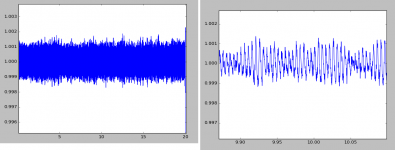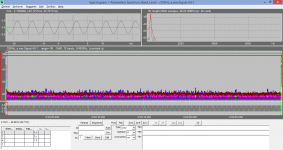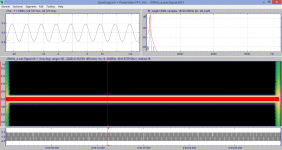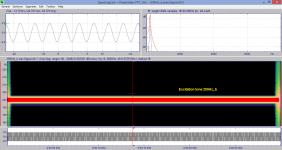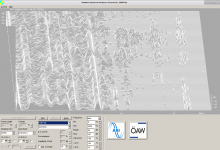The problem, with the truth, is that we all tend to prefer ours than the ones others want to impose on us.
If you read more of Mr. Fredriksen's papers you can see that the distortion modeled as that of a weakly non-linear system with no discontinuities matches reality fairly well. This means the THD and IMD are both predictable and directly related. Of course this alone would not meet NIST standards.
OTOH we ARE wrong because we have not taken into account the diaphragm displacement. The net displacement caused by the 13K and 14K is small compared to 1k so one of the tones must exercise the diaphragm at a low frequency for a valid test.
Scott,
I have already mentioned that paper. It is in my collection.
One of the issues is infrasonic energy. In condenser microphones there is usually a small hole in the back plate to allow pressure equalization. This also affects the very low frequency response. That is a good thing. If you ever look at the very low frequency energy levels, it can be amazing. Lots of energy ranging from motor unbalance vibrations below 30 Hz. to incredible spikes from lightning enough away you don't hear the normal higher frequency components. These will affect real world measurements but probably not in the high volume test chamber.
Then just because the intermodulation distortion is predictable does not mean it is low enough to allow the measurements under consideration.
There have been several methods mentioned on how to check the base level distortion of a measurement system to look at loudspeaker distortion reduction. The simplest is to make a measurement with and without the feedback. This can be done with a complex analysis.
Scott,
I have already mentioned that paper. It is in my collection.
One of the issues is infrasonic energy.
I think we can collectivly conquer this problem. As for infrasonic energy and non-stationarity of air how about this. I plotted the instantaneous frequency of PMA's 200Hz_a file and you can see +-0.1% PM (some from the backround HVAC, etc.). The plot is normalized, horizontal axis is time in seconds. Audibility of jitter, right.
Attachments
Last edited:
The problem, with the truth, is that we all tend to prefer ours than the ones others want to impose on us.
True 🙄
+/- .1% seems like a low number. -60 dB doesn't for audio issues. (Or should we really consider it -30 dB?)
Normal vibration levels are around .01G from both my measurements and my acoustics friends. Of course that number doesn't hold some days in California!
For humor we want to see a minimum 10dB signal to noise ratio when we adjust the loudspeaker frequency response equalization in a large venue. Not as easy as that would seem. Daytime in a new venue, lots of construction noise. Nightime, neighbors will complain about the noise. One construction manager acknowledged the need for quiet time and scheduled it at the same time as final cleanup including pressure washing!
Now there are methods to adjust the loudspeaker system frequency response at levels where the test signal is enough below the ambient noise to not be perceived. Unfortunately that dramatically increases the time for each measurement. Generally I like a measurement point for about every 50 seats. So for a stadium that would take around 1,000 hours using the quiet method. Noisy method allows multiple measurements at the same time and can be done in a work day or two.
Now in the case under discussion it seems 80-100 dB of signal to noise would be required, but not actually. The noise levèl is broadband and the distortion signals can be very narrow. However it does require the band under measurement to meet those numbers. Now the simplest method to clean up the acoustic measurement ain't actually difficult. The measurement microphone can be placed in an acoustic filter that will reduce the excitation signals and pass the distortion frequencies in an intermodulation distortion test.
In simple words a tube can be placed over the microphone capsule and the length will provide the tuning.
Normal vibration levels are around .01G from both my measurements and my acoustics friends. Of course that number doesn't hold some days in California!
For humor we want to see a minimum 10dB signal to noise ratio when we adjust the loudspeaker frequency response equalization in a large venue. Not as easy as that would seem. Daytime in a new venue, lots of construction noise. Nightime, neighbors will complain about the noise. One construction manager acknowledged the need for quiet time and scheduled it at the same time as final cleanup including pressure washing!
Now there are methods to adjust the loudspeaker system frequency response at levels where the test signal is enough below the ambient noise to not be perceived. Unfortunately that dramatically increases the time for each measurement. Generally I like a measurement point for about every 50 seats. So for a stadium that would take around 1,000 hours using the quiet method. Noisy method allows multiple measurements at the same time and can be done in a work day or two.
Now in the case under discussion it seems 80-100 dB of signal to noise would be required, but not actually. The noise levèl is broadband and the distortion signals can be very narrow. However it does require the band under measurement to meet those numbers. Now the simplest method to clean up the acoustic measurement ain't actually difficult. The measurement microphone can be placed in an acoustic filter that will reduce the excitation signals and pass the distortion frequencies in an intermodulation distortion test.
In simple words a tube can be placed over the microphone capsule and the length will provide the tuning.
So you actually don't, I'll have to remember that and not waste the time.
https://www.icacommission.org/Proceedings/ICA2004Kyoto/pdf/Mo4.E.2.pdf
Thanks for the reference. Turns out I have an Endevco 2510. Now I know what to do with it and how low its distortion is. Next to figure out an appropriate preamp. Maybe a charge amp? Seems I have the right one. Just need to find a cable with that connector. Now I'll be instrumented for the next Saturn V takeoff.
I think we can collectivly conquer this problem. As for infrasonic energy and non-stationarity of air how about this. I plotted the instantaneous frequency of PMA's 200Hz_a file and you can see +-0.1% PM (some from the backround HVAC, etc.). The plot is normalized, horizontal axis is time in seconds. Audibility of jitter, right.
Very interesting plot. Would you mind mentioning how you created it?
perhaps a least squares fit to a pure 200Hz sine wave?Very interesting plot. Would you mind mentioning how you created it?
OK, understood and agreed. But, and that is the point, this only considering the *raw* response mechanism, not what we get at the output. Once the signal is EQd to give flat output for flat input SPL the phase is back were it needs to be (at zero). If otherwise this would violate systems theory...Handbook for Sound Engineers contains an excellent monography on microphones. I would look it up for you but unfortunately can't at the moment.
The fact that electrical wave form from moving coil mike runs 90 degrees behind the acoustical wave should be obvious from working principles. At zero crossings of the acoustical wave, velocity of the diaphragm is highest and thus output.
Condensor mike has highest output at crest of sound wave so is in phase.
Is that really true outside of the stupidly expensive musical instruments such as the U47 which have a sonic signature bordering on 'broken'?
2018 Pro Sound Awards: Neumann U 67 Awarded “Best Studio Microphone”
Very interesting plot. Would you mind mentioning how you created it?
The derivative of the unwrapped phase of the Hilbert transform gives the instantaneous frequency. The magnitude of the Hibert transform gives the instananeous amplitude. The separation of the two can be very good.
I'm making the assumption here that with one tone we are seeing phase modulation due to the cone motion (@200Hz) and the equipment vibrations? This is just a first experiment I never tried this before and don't have answers.
Ed - This is instantaneous frequency only, I don't know how to find a weighting for the angle of incidence on the mic (if that matters). I think some tests with IM and various frequencies and noting the exact setup might be useful.
Looks quite useful. Realtime waterfall charts!
Attachments
The derivative of the unwrapped phase of the Hilbert transform gives the instantaneous frequency. The magnitude of the Hibert transform gives the instananeous amplitude. The separation of the two can be very good.
Looks like you knocked it up in Excel?
Looks like you knocked it up in Excel?
No I'm using the same Python stuff that we did for the TT speed stability thread. Looking for ways to reduce the noise and help with the measurement uncertainty.
Last edited:
Now I get it.
Mr. Hilbert makes transformers and he sells them through Python stores.
Are they good? I want to buy some.
😀
George
Mr. Hilbert makes transformers and he sells them through Python stores.
Are they good? I want to buy some.
😀
George
Now I get it.
Mr. Hilbert makes transformers and he sells them through Python stores.
Are they good? I want to buy some.
I'm afraid not good enough in this case, the backround noise appears to cause contamination in this single tone test. I need to look at some data like 200Hz and 10kHz mixed from two separate sources. So ignore for now the first results.
200Hz and 10kHz from 2 sources? I can do it, if you do not mind some distortion from 200Hz source.
200Hz and 10kHz from 2 sources? I can do it, if you do not mind some distortion from 200Hz source.
No problem, It helped a lot that your 200Hz was exactly 200Hz if possible to 10k should be too.
- Status
- Not open for further replies.
- Home
- Member Areas
- The Lounge
- John Curl's Blowtorch preamplifier part III
